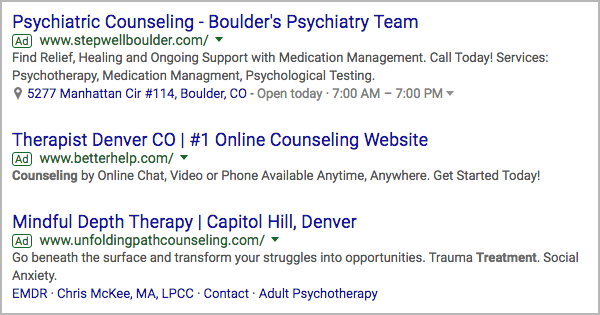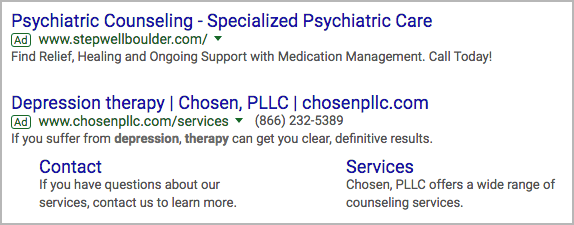How to Write a Better Paid Ad for Your Practice
You’re finally ready to put your private practice on the map. So ready, in fact, that you’re willing to spend your own cash to purchase some paid advertisements on the web.
Paid advertising networks like Google or Facebook have plenty of tutorials and third-party platforms willing to teach you the technical aspects of how to actually create and input your paid ads. However, practically none of them will offer advice on how to make your ad good.
(Of course, none of those guides are made specifically for therapists – for you – like ours is! Try out Therapist’s Guide to Google AdWords if you’re looking for more of a technical guide for Google and Facebook ads.)
–> PSST! Looking for creative marketing for your practice? <–
Take our free course on 8 Unconventional Marketing Tips!
How do you get people to like your ad? How do you get them to put whatever they were doing on hold, and click on something they only saw for a second or two?
One of the best things you can do to increase the performance of your paid ads is to write them better.
Your ad copy (the main text portion of a paid advertisement) is the engine behind the persuasive power of your ad. So if you’re willing to roll up your sleeves and pop the hood, a tune-up could end up making a big difference in your ad results.
How to Write Better Paid Ads for Your Practice
1. Keywords, keywords, keywords.

Including the right keywords means that you’ll be targeting the specific search phrases your ideal clients are using. People want to click on ads that appeal to them – that are relevant to them. Using keywords in your ad copy makes the ad more relevant to your target clients and their unique search queries.
(If you’re looking for a more in-depth explanation about what “keywords” are and how you pick your own, check out our Therapist’s Adword Guide.)
A good rule of thumb is using between one and two keywords or keyword phrases in your ad copy. After all, with only 25 characters to work with in some cases, you need to make the best of the space you have!
2. Don’t forget your call to action (CTA)!
You may know “calls to action” mostly as buttons or clickable links that you place on your practice website. In this case, however, we’re talking specifically about the language that you use in your paid ad to call your readers to the next action you want them to take.
Does your ad only tout your own expertise? Or does it actually mention what potential clients can do to get involved, or to reach out?
Adding something as simple as an urging for your potential clients to “get in touch,” or “contact me” is an important step in increasing your engagement rate. You’ll be surprised by how many people take you up on your suggestion!
–> Looking for ways to get even MORE clients? <–
Take our free e-course on 5 Unique Client-Grabbing Tips!
Let’s take a look at an example of this in some actual ads:
All three of these ads are clear about the kind of help they are offering, but you’ll notice how the first two ads stand out because they both ask their reader to take a specific action in order to move forward – “Call Today!” “…Online Chat, Video, or Phone… Get Started Today!”
However, the third ad – the one for “Mindful Depth Therapy” – is non-descript on what it wants its readers to do next. Even though it generally describes how the services might be helpful to the reader, it’s overall less powerful than the first two ads. To be more compelling, it should encourage us to take the action most desirable to the owner, like a prompt to “sign up,” or “reach out,” or even “make an appointment.”
3. Use personal language.

Let’s look at this in action:
Both of these ads have clear CTAs and use keywords, and they are both clear about what their message or their pitch is. However, one of them connects far more personally with the reader. Why? For the simple reason that the second ad uses the word “you” to connect to their audience – “Get the Help You Need Now.”
Just using the word once is enough to set the ad for “Affordable Counseling Online” apart from the competing ad for “Psychiatric Counseling.” Imagine if you used “you” or “your” even more in your own ad copy!
4. Avoid therapist mumbo-jumbo.
Sometimes we’re our own worst enemies. While you know the “correct” terms for psychiatric conditions and feelings, those aren’t always the best words to use when you’re trying to connect with a reader in such a short amount of time.
For example, say you’re trying to demonstrate that you understand some of the symptoms your target client is experiencing as part of anxiety. Instead of writing, “Discover the root of your insomnia and obsessive thoughts,” try to think of how your target client would think of that experience as an anxiety sufferer. Instead, you might use language like, “Can’t get to sleep? Thoughts running around your head?”
Let’s compare two different paid ads again:
As a potential client, this first ad doesn’t immediately grab me. When I read this I’m thinking, “I was searching for a depression therapist, why am I reading about Rapid Resolution Therapy?” Instead of intriguing me enough to want to learn more, my interest is extinguished right away because I don’t understand what is being pitched without a further explanation. Part of getting someone to click on your ad is making a connection with them, and it’s difficult to connect when you’re not speaking the same language.
This second ad is a totally different story. “Do You Constantly Feel Sad, Worried And Hopeless?” As a potential client, that sounds like what I’m feeling! I understand immediately why this ad applies to me and why I might benefit from learning more. When you think of symptoms and conditions from your client’s point of view, your ad copy will become far more personal to them – and therefore more effective for you.
5. Test, test, and test again!

One important thing to learn about writing is that all great writing comes from revision. Testing and re-testing your ad copy to see what combination of words does well (and what combination doesn’t) is an essential step to making your paid ad the very best it can be.
Some of the key stats you should keep on your radar are both the total number of clicks you’re getting, your cost-per-click, and your cost-per-conversion (“conversion” here means whenever someone actually takes the next step to become your client, whether that’s scheduling a consultation or submitting their information for a call-back). Even if your paid ad is getting a decent amount of clicks, it might be costing you more money than its worth if your cost-per-click or cost-per-conversation is very high.
What is “very high” when it comes to cost-per-click or cost-per-conversion? Unfortunately there’s no set number that works for everyone because it depends on how much each conversion or click is worth to you. You’ll want to do the math and find out what the average profit is that you make on each click or conversion, including the clicks and conversions that don’t end up earning you anything. Whatever that number is, that’s the highest your click-per-conversion can get before you start paying more for your conversions than they are earning you.
It’s a good idea to get in the habit of coming back to check on your paid ads after a couple days to see how they’re performing. Once you’ve done this a few times, you’ll start to establish a performance baseline for your ads so you understand when and how your ads are exceeding expectations.
I bet your paid ads are looking so much better already! Remember that testing your ad will be the most crucial step to make your ad copy better – but it also gives you the freedom to experiment!
Go ahead, try out that catchy new ad copy you thought of in the shower! If it doesn’t work out as well as you hoped, your new testing-and-checking habit will make sure you know right away, and you can always change it.
Looking for even more help with writing for your practice? Check out our exclusive mini-series, Writing Your Way to a 6-Figure Practice!
Want to know when we release new content for this series? Sign up below!







